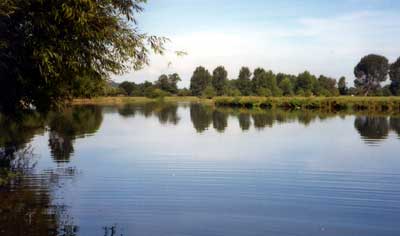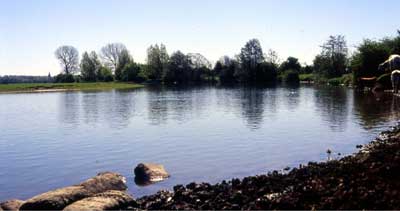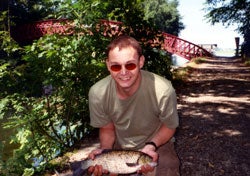| MARK WINTLE |
| Mark Wintle, an angler for thirty-five years, is on a quest to discover and bring to you the magic of fishing. Previously heavily involved with match fishing he now fishes for the sheer fun of it. With an open and enquiring mind, each week Mark will bring to you articles on fishing different rivers, different methods and what makes rivers, and occasionally stillwaters, tick. Add to this a mixed bag of articles on catching big fish, tackle design, angling politics and a few surprises. Are you stuck in a rut fishing the same swim every week? Do you dare to try something different and see a whole new world of angling open up? Yes? Then read Mark Wintle’s regular weekly column. |
AN OXFORD EDUCATION
At the start of my column I promised to get out on some different rivers. I decided to ease myself into this gently by revisiting the river where I had my very first fishing trips forty years ago. My family all come from Oxford so it was on a trip to see various uncles and aunts that I first tried to catch fish. Since then I have fished the Thames many times but during the last decade my visits have dwindled so a trip was long overdue. Over the years, the river has changed a lot but at least I have some ideas on what to expect.
I decided to visit the Medley reach just upstream of the centre of Oxford. This stretch is broad, about fifty yards wide, and shallow, with open meadows opposite. The depth is five to seven feet. At the bottom end of the stretch, the river splits at an island and the main channel continues into Oxford with a reduced width of about 25yds. The shallow margins are often weedy. So, on a hot day in early August, I loaded up the car with tackle and enough bait to raise the level by a foot and set off. Parking in Binsey Lane near the Perch Inn I set off down the track to the river. Here and there, bleak dimple the surface but little else is moving. I choose a swim about a hundred yards upstream on the basis of past form and get set up. Settling out the stall First job is to set up the keepnet, bait stand and landing net. The margins are very shallow and I prefer to wade out about five or six yards and stand in eighteen inches of water. The water is clear and I am able to see the bottom in over four feet of water. There is a lot of blanket weed on the bottom. I set up a 13ft match rod with fixed spool reel loaded with 2lbs Maxima. A simple insert waggler is locked with two AAA shot about 5ft from a size 20 hook. A bunch of six no. 4 shot is squeezed on the line just above the hooklength with two no. 8 shot as droppers below that. I’m hoping that the bunch of shot will get the bait through the bleak. I start fishing, using single bronze maggot as bait. By feeding heavily every third cast with three pouchfuls of maggot plus one of hemp, I hope to get some past the bleak. I also feed just hemp about 10yds out, five yards inside my main feed line. At first, nothing much happens. Then the bleak arrive. They don’t get the bait every time but even when the bait gets through unscathed, no bites are forthcoming. It’s a matter of persevering until something better turns up. A surprise monster After half an hour the first perch turns up, a lively fish of about 10oz. It’s a start, and not long before another two or three show. These are smaller. I’m puzzled by the lack of roach. There must be some about surely? The bleak return at times, holding up the bulk shots so the float lifts out of the water. Another net perch is encouraging. Then I get a fish that feels different – a roach at last. As I draw it to the surface, it’s only about 3oz, a truly enormous perch appears behind it. I am staggered for it looks every ounce of four pounds. The perch backs off leaving me wondering how I could go about catching it. I have some small red worms, or perhaps if I could catch a gudgeon and use that as bait? I have been trying caster as bait to try to beat the bleak and five minutes after seeing the perch I get a bite. It briefly feels like a roach before it goes off in a series of short unstoppable runs towards the far bank. There is a big weedbed over there and the fish breaks the hooklength in the weed. I have a suspicion that was the big perch.
Time to try the Channel When I get down there I find swimmers diving off a concrete ledge about two hundred yards below the bridge, right where one of the best chub swims used to be. I put my gear down about 70yds below the bridge and scan the far bank. I spot a good chub about twenty yards up by an overhanging far-bank bush. This looks promising. Moving my gear opposite the bush, I spot more chub. There are about six out there, all between three and four pounds. Before retackling with a 2AAA waggler, I feed a couple of big pouchfuls of casters across by the bush. It looks promising as the chub quickly mop up the feed. I finish tackling up by setting the float at 3ft deep with just two no. 10 shot down the line. The hook is a Drennan Carbon Chub 18 tied to 0.12mm Ignesti Special. Before my first cast using double caster as hookbait, I feed three more times to get the chub feeding confidently.
By now, there is little sign of the shoal as half of them are in the keepnet. About twenty minutes later, I get a fourth and final chub by deepening by a foot to drag the bottom. This one is followed across the river by another chub that bolts at the sight of the landing net and probably takes what is left of the shoal with him. At 4lb 2oz it’s easily the best fish. After this, all I can get are tiny chub and a gudgeon. I rope in a passing tourist to take a quick snap and try to figure my next move. I walk to the point of Fiddlers Island by Rainbow Bridge. The river splits here, and directly upstream of the point I spot a big shoal of roach in about 4ft of water. No monsters, just fish up to half a pound, but worth a try anyway. I get my gear and retackle again, this time with a little stick float taking just 3 no. 4 and a 16 fine wire hook. Bait is double caster though I hope to get tares to work. Regular feeding of hemp and caster soon starts to bring regular bites from the roach, but no joy with the tares. An added bonus is that the bleak keep away so that I’m able to keep the roach going until it is time to pack up. I get about twenty up to half a pound to round off a hot but enjoyable day. Though I was familiar with the area, the river changes over the years and seasons so as ever to get sport the basic tenet of finding the fish has proved vital. Even on a big river like the Thames, this remains true. I can’t help thinking that I should have had a proper crack at the big perch, possibly using a bleak as bait. The vital ingredient of catching the chub was pinpoint casting with a waggler. This is something that I have done for many years and continue to practice on a regular basis. Though I have fished with three different floats the same match rod and line has proved ideal for all circumstances. Despite the boats and disturbance, the Thames has much to offer today’s angler with lots of day ticket and club water available. Find the fish, crack the method and who knows what you might get. It is a big river, with loads of different stretches. Turn up on the off-chance and the chances are you will struggle. Seek out likely areas and methods, check out favourable conditions and who knows that 4lb perch might be yours. Anyone familiar with Peter Stone’s articles in latter years in Coarse Fisherman will recall how Peter described the tremendous potential of the Thames. Not just for perch and chub but also barbel and carp, and of course there are also plenty of bream as well as tench to be found. NEXT WEEK: ‘Fish Introductions in Rivers’ |
















